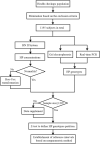Genotype-specific reference interval of haptoglobin tests in a Chinese population on the BN II System
- PMID: 36631470
- PMCID: PMC9834205
- DOI: 10.1038/s41598-022-20496-x
Genotype-specific reference interval of haptoglobin tests in a Chinese population on the BN II System
Abstract
The distribution of Haptoglobin (HP) subtypes differs according to race and geography. It was also confirmed that the serum HP concentration was substantially affected by the HP subtypes. This study aimed to investigate the HP subtypes in northern Chinese and to establish reference intervals for the major HP subtypes using the BN II system. 1195 individuals were included in the study, grouped by haptoglobin subtype, and tested for concentrations by BN II System. Analysis of reference range was performed according to the EP28-A3c guideline. The need to establish reference ranges for subtype, gender, and age groupings was confirmed by the Z-test. The 2.5th and 97.5th percentiles were used as the upper and lower limits of the reference interval, respectively. In the population we investigated, the HP2-2 subtype had the highest proportion, accounting for 49.3%, followed by HP2-1 (38.0%), HP1-1 (7.2%). In addition, about 5.5% of individuals had HPdel-related subtypes. The concentrations of the major subtypes (HP1-1, HP2-1, HP2-2) were significantly different, and it was necessary to establish reference ranges by grouping according to the results of the Z-test. The reference intervals were as follows: HP1-1, 0.37-2.19 g/L; HP2-1, 0.38-2.12 g/L; HP2-2, 0.12-1.51 g/L. Significant differences in HP concentrations between genders and ages were found, however, it was not necessary to establish separate reference interval since the results of the Z-test was negative. We have established reference ranges of serum haptoglobin concentrations based on subtypes, which are necessary for the clinical application of haptoglobin.
© 2023. The Author(s).
Conflict of interest statement
The authors declare no competing interests.
Figures
Similar articles
-
Haptoglobin genotype and outcome after spontaneous intracerebral haemorrhage.J Neurol Neurosurg Psychiatry. 2020 Mar;91(3):298-304. doi: 10.1136/jnnp-2019-321774. Epub 2020 Jan 10. J Neurol Neurosurg Psychiatry. 2020. PMID: 31924654 Free PMC article.
-
Does haptoglobin genotype affect early onset of diabetic retinopathy in patients with type 2 diabetes?Retina. 2011 Sep;31(8):1574-80. doi: 10.1097/IAE.0b013e31820a68f8. Retina. 2011. PMID: 21555971
-
Haptoglobin Genotypes Associated with Vaso-Occlusive Crisis in Sickle Cell Anemia Patients of Eastern India.Hemoglobin. 2021 Nov;45(6):358-364. doi: 10.1080/03630269.2020.1801459. Epub 2021 Jan 3. Hemoglobin. 2021. PMID: 33393394
-
Haptoglobin: a review of the major allele frequencies worldwide and their association with diseases.Int J Lab Hematol. 2007 Apr;29(2):92-110. doi: 10.1111/j.1751-553X.2007.00898.x. Int J Lab Hematol. 2007. PMID: 17474882 Review.
-
[Haptoglobin as a biomarker].Biomed Khim. 2021 Mar;67(2):105-118. doi: 10.18097/PBMC20216702105. Biomed Khim. 2021. PMID: 33860767 Review. Russian.
Cited by
-
Relationship between time-varying achieved HbA1c and risk of coronary artery disease events among common haptoglobin phenotype groups with type 2 diabetes: the ADVANCE study.BMJ Open Diabetes Res Care. 2025 May 6;13(3):e004713. doi: 10.1136/bmjdrc-2024-004713. BMJ Open Diabetes Res Care. 2025. PMID: 40328645 Free PMC article.
References
Publication types
MeSH terms
Substances
LinkOut - more resources
Full Text Sources
Research Materials
Miscellaneous



